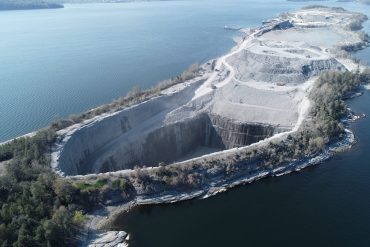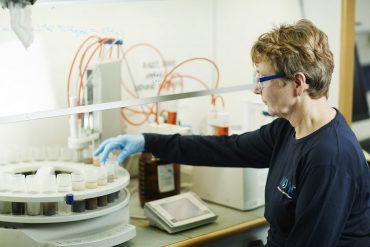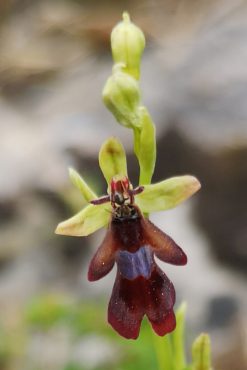Investment in new treatment technology may extent industrial waste capacity on Langøya
In a letter from June, the Norwegian Environment Agency requested that NOAH assess the possibilities of extended capacity for final treatment of inorganic hazardous waste on Langøya.
Through research, development and testing, NOAH has continuously worked on improving its treatment processes. On this basis, NOAH has since spring 2020 shown, by way of stable production, that the gypsum resulting from the process satisfies the requirements for what is referred to in the regulations as ‘Stable, non-reactive hazardous waste’, with the exception of salt content. The salt content does not impact the water quality of the receiving water, which is seawater. Stable, non-reactive hazardous waste does not result in more leaching than ordinary waste originally planned to be deposited above sea level on Langøya.

Investment in new treatment technology may extent industrial capacity
By changing the composition of materials and treatment process, NOAH’s research shows that final treatment capacity for hazardous waste can be extended until between 2027 and 2030.
“The solution depends on two factors. First: Through improved processing, the processed waste satisfies the leaching criteria for ordinary waste. We can thereby utilise the landfill volume allocated for ordinary waste for large portions of the hazardous waste. At the same time, there will be a need for a smaller landfill volume for hazardous waste for the residual amounts that do meet the organic waste requirements. Second: By investing in a filter press, we can minimise the volumes by extracting large amounts of water from the processed waste. The latter solution will also enable increased salt recovery”, explains Group CEO Anders Lægreid.

In 2020, NOAH has conducted tests showing that the processes at Langøya can meet the requirement for leaching of Stable, non-reactive waste for large portions of the waste NOAH is currently receiving. Investment in a filter press will result in more efficient use of the landfill and has therefore long been on the agenda.
NOAH’s letter to the Norwegian Environment Agency of 15/9/2020 outlines a theoretic opportunity space for extended receiving capacity for hazardous waste on Langøya. NOAH will develop robust business solutions and discuss environmentally sound solutions with the environmental authorities.
Development project until next summer: A business management decision
Until May 2021, NOAH will continue ongoing test projects for production of Stable, non-reactive hazardous waste.
“At present, the results are very satisfactory, but we are choosing to continue the development project until May 2021, to ensure the thoroughness of tests and that possible effects of seasonal changes on the waste are also documented”, says Lægreid.
An optimisation of final processing capacity for inorganic, hazardous waste on Langøya will have a significant impact on NOAH’s business. Among other things, an extension will entail a large investment, in addition to markedly increased operating expenses.
“An optimisation on Langøya will contribute to safeguarding expertise in NOAH and local jobs, but there is a considerable need for investment with a potentially short depreciation period. We have not concluded whether a possible solution is economically feasible but will conduct detailed studies to determine this in the autumn”, says Lægreid.
If the authorities wish to proceed with the outlined opportunities, it will be important for NOAH that the receiving capacity for ordinary waste is maintained,.
“We are looking at new solutions elsewhere in the country. Two weeks ago, we completed the acquisition of Rekefjord Stone, which, in addition to continuing quarrying and sale of rock, will seek to establish reception of ordinary, inorganic waste. However, it is uncertain how long it will take before NOAH can receive ordinary waste in Rekefjord”, says Anders Lægreid.

Decision regarding increased use in cooperation with national and local authorities
NOAH has been granted permission by the Norwegian Environment Agency to deposit hazardous waste on Langøya until 2026 and ordinary waste until 2029. An optimisation of the capacity on Langøya will have to be approved by the environmental authorities and also needs to be clarified in close cooperation with Holmestrand municipality.
“With safe and secure handling as the top priority, NOAH will continue to be a leader in the safe processing of society’s refuse products.
This will occur in consultation with national and local authorities”, says Lægreid.
New use of the landfill volumes on Langøya as described will likely result in an extension of the vehicle transport of hazardous waste to Langøya. NOAH is currently working on a zoning plan for a new wharf, which will result in the redirecting of vehicle transport outside central Holmestrand.
Firm stance on landfill closure in 2034
According to the permit from the Norwegian Environment Agency, covering of all landfills must be completed by 2034. Industrially, NOAH will probably remain on Langøya for longer than this, but the company has determined that depositing will in any case be discontinued in accordance with the current schedule.
“Once depositing has been discontinued, the last part of the landfill will be rehabilitated and mainly be used as a public recreation area. This issue is about how we can safely and in accordance with regulations optimise the current capacity on Langøya”, says Lægreid.
